PRESERVATION CHALLENGES
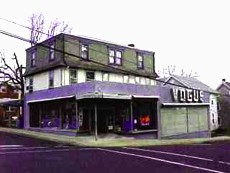 |
The historic building located at 529 Chestnut
Streets (Sixth & Chestnut Streets) in Perkasie clearly shows
the combination of two architectural styles. Though structurally
combined these two styles are not integrated in design. What
does the preservationist do for such a challenging problem? Return
the building to its original style - a very expensive proposition.
There are no easy answers to this question. |
BUILDING HISTORY
On the 1876 map of Perkasie this property was that of J.
Summers on Main Street. During the 1890's the building was used
as a rooming house for itinerant cigar makers;. At that time there
were 20 rooms on the second & third floors and a "home
comfort" restaurant on the first floor. A green grocery store
was located at this location and the American Store occupied part
of that building during the 1920's. From 1915 to 1945 this building
at Sixth & Chestnut Streets was a clothing store run by Jonas
Apfelbaum.
In 1945 the building was purchased by Mr. & Mrs. Frank
C. Schultz, owners of the Vogue Shoppe, a millinery store located
at 113 South Fifth Street. Extensive alterations were made and
the Vogue shop opened in 1949 at the Sixth & Chestnut Street
location. The building is now being used by McGonigal's Music
Studio.
SECOND EMPIRE OR ART DECO STYLE BUILDING?
SECOND EMPIRE
| 
SECOND EMPIRE CHARACTERISTICS
The original building is built in the Second Empire style. This
style originated in France. The double-pitched roof with a steep lower
slope is called a mansard roof. This distinctive feature of the second
empire style creates an additional usable floor. There are several mansard
roof buildings in Perkasie today.
In the Second Empire style, numerous windows or dormers are used
to provide light on the mansard roof level. Windows often appear in
pairs (see photo at top). The building itself is usually symmetrical
in design ( as this building once was from Chestnut Street). Classical
elements (columns) are and a sense of formality are also associated
with this style. |
|
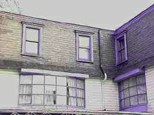
Windows in the mansard roof are probably original. The two bay windows
on the second floor are clearly not characteristics of the original
Second Empire style.
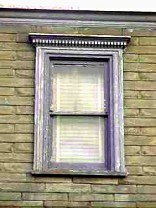
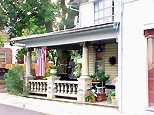
|
ART DECO
Art deco ornamentation consists of low-relief geometric
designs. Parallel straight lines, zigzags, chevrons, and stylized
floral designs are typical art deco designs. Smooth surfaced metal
and glass wrap around this corner with a streamlined feel. At
the store front on street level most people do not notice the
combination of two styles; one one stands at a distance they see
how the designs do not relate with one another. There is no effort
to integrate the designs together. This is the only example of
art deco architectural design in the town of Perkasie.
|

ART DECO CHARACTERISTICS
The art deco (also called Modernistic, Art Moderne, and
Streamlined) style was first popular in the 1930's. The repetitive
geometric forms and horizontal bands of windows with trim patterns
of repeating parallel lines are typical of this style.
Rounded corners (see right) and windows are also typical
of the style. These geometric forms give the design a "streamlined"
effect.
|
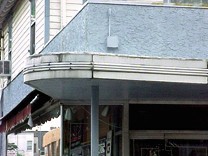
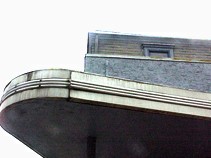
|
| 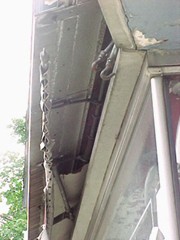
UNIQUE AWNING
Typical of the streamlined design of art deco this building has
an awning that can be recessed under a flap that when closed appears
to be merely a series of repeating geometric bands. |
|

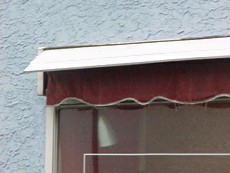
|









